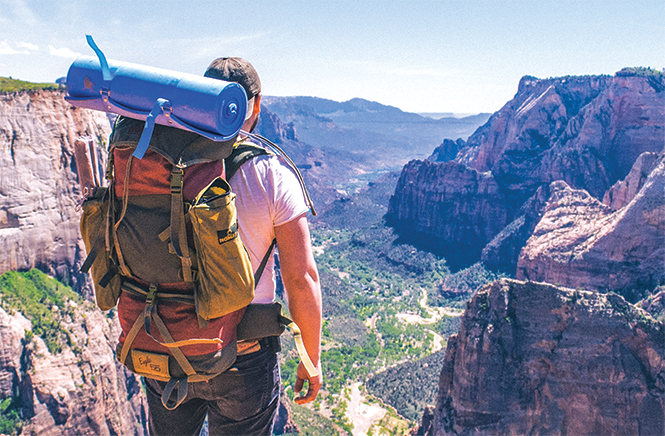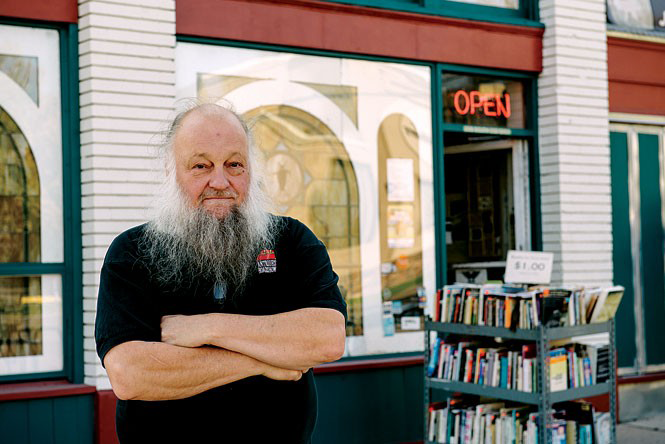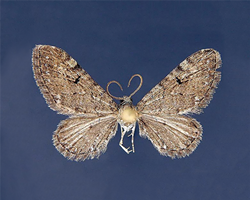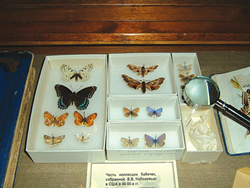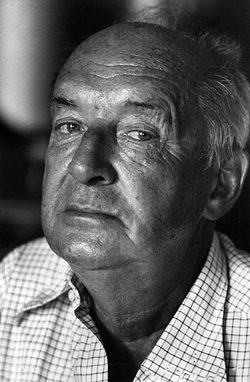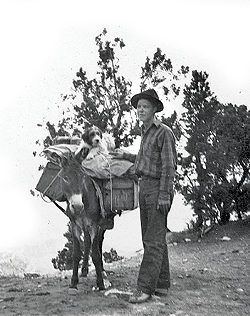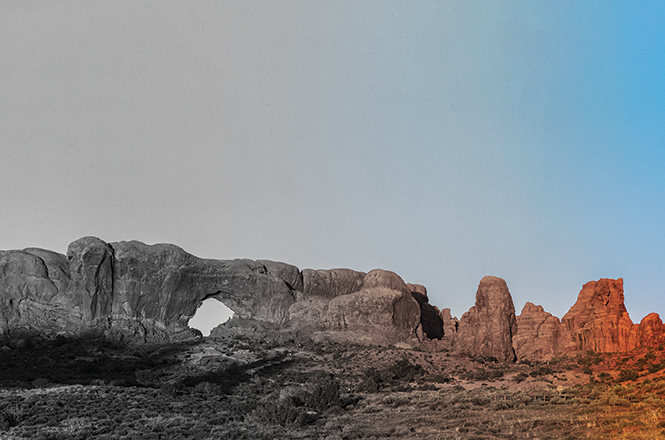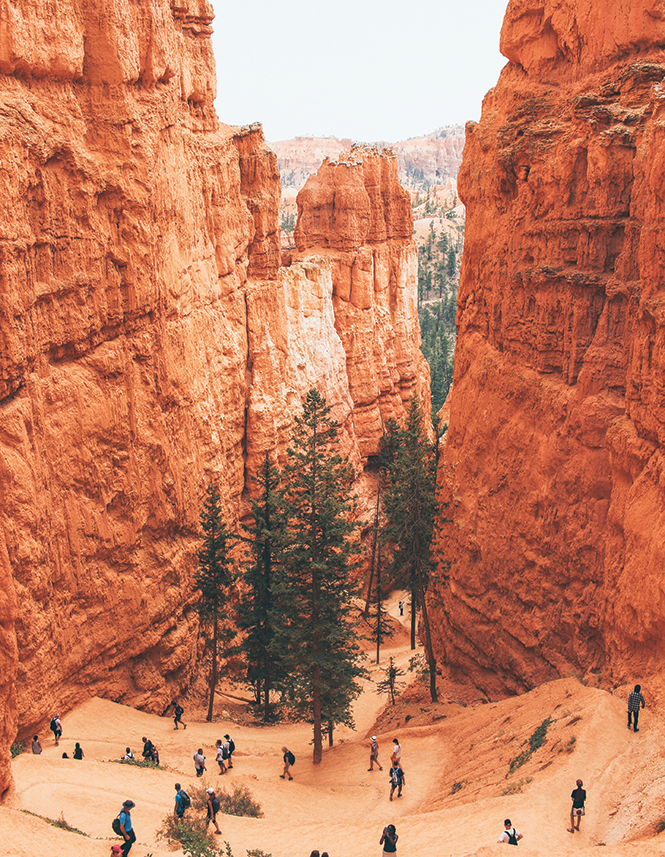Tales for Road Warriors
Those who staked out Utah's wilderness, both in life and the printed word
By John RasmusonWe get it. This "hunkering down" idea has you second-guessing all your summer plans. As the state's coronavirus "colors" shift—from red to orange to yellow, to, what is it now, chartreuse?—and cases of COVID-19 continue to slowly rise, you may not be convinced that a road trip to small-town Utah and our national/state parks makes sense in these pandemic times. After all, it was recreational travel that imported the early cases of the virus from cruise ships and other ski resorts into Utah.
Not only that, but your bank account may be stretched a little thin right now with downsizing, layoffs and furloughs threatening like a dark cloud.
So, for this summer, if you can only access Utah's backcountry via the printed word, you can take heart knowing you have rich literary options at your fingertips.
John Rasmuson—a longtime writer for City Weekly and magazines Devour Utah and Vamoose Utah—penned the following essays on Vladimir Nabokov, Bernard DeVoto, Everett Ruess and Edward Abbey for our outdoor/adventure journal, Vamoose Utah. We're republishing them here along with reading recommendations by Utah rare book dealer, Ken Sanders, to guide you in your discovery of these authors.
Catching Up With Ken
The meaning and the cleaning
Ken Sanders began working in the book business in the 1970s, founding Ken Sanders Rare Books in 1997. As one of a handful of Salt Lake's much-loved independent booksellers, Sanders' shop is a downtown watering hole for the literary West, with books on Utah and the Mormons, Western and Native Americana, travel and exploration plus rare maps and photographs. He is passionate about local arts and literature and has hosted countless book signings, art exhibitions and poetry readings. And his bearded visage makes regular appearances on PBS' Antiques Roadshow where he serves as a book appraiser.
Sanders bookstore has lately been the focus of news stories about downtown developments that will force him out of his 4,000-square-foot building within two years. Closing his doors this spring to slow the spread of COVID-19 also didn't help, but Sanders ain't down yet.
How he become aware of the pandemic's reach
In March, I drove to Albuquerque to exhibit at the small regional antiquarian book fair there. On Thursday, March 12, after unloading my stock at the Albuquerque Balloon Park, I met a buddy for dinner and drinks at our hotel. During our dinner, the book fair promoter called to say the mayor had just shut down all the city's public gatherings. And the book fair was canceled.
At breakfast the next morning, Friday the 13th, we contemplated our fate, prior to driving 600 miles home without a sale in either of our pockets.
The virus' impact on Ken Sanders Rare Books
We have been closed since mid-March and have just started opening up by appointment last week. I have kept my entire staff on payroll as well. We are working twice the hours to make half the money. Business is off by half. I have worked seven days a week since mid-March. I go home at night to eat and sleep.
Cleaning and more cleaning at the newly opened shop
Everyone who enters the store must use hand sanitizer and wear masks. (Masks, gloves and hand sanitizer are available upon entry.)
Only six people at a time are allowed in the shop. There's lots of cleaning, social distancing and a giant plexiglass plague wall surrounding the front counter to protect everyone. We have deep-cleaned the shop, and we sanitize all surfaces and handles after every use. The restroom is not available to customers. Customers must bag their own books.
What's the outlook for Ken Sanders Rare Books—not only the pandemic but the shop's impending move?
I have always sold books. I will always sell books. I have been doing it for 50 years so far, and I have an inventory of over 100,000 books. We will find a way despite the uncertainty of the present, and the near future.
How to find books by the authors mentioned on the following pages
We have always championed Utah and regional authors and our stock is plentiful. Call, email us or visit us online:
Ken Sanders Rare Books
268 S. 200 East, SLC
801-521-3819
KenSandersBooks.com
In Pursuit of Butterflies:
Russian novelist Vladimir Nabokov may be most famous for Lolita, but Utahns can thank him for their pug
For some, Vladimir Nabokov's Lolita is the greatest novel of the 20th century. For others, Lolita is an unredeemed story told by a pedophile named Humbert. The fact that the book has Utah roots is another story, but it's more about road trips and butterflies than nymphets and illicit sex.
The back story is the novelist himself. The son of Russian nobility who fled the Bolsheviks for Europe, Nabokov had published nine books in the Russian language before settling in Massachusetts in 1940 at the age of 44. He taught literature courses at Wellesley College, but his abiding interest was lepidopterology. Among his credits is the butterfly collection at Harvard's Museum of Comparative Zoology.
The pursuit of butterflies caused him to crisscross the United States 13 times between 1941 and 1958, logging 200,000 miles on two-lane highways like Route 89. According to Robert Roper's Nabokov in America, he was drawn to "motor courts that cost a dollar or two a night, in towns so patly, Americanly themselves that a visitor had to smile." Nabokov's road trips brought him to New Mexico and Arizona in 1941 and to Utah for the first time in the summer of 1943 where he rented a room at the four-year-old Alta Lodge.
The road trip is an American tradition that has generated its own canon. Think of writers John Steinbeck, Jack Kerouac and William Least Heat Moon. Journalist Charles Kuralt ran six RVs into the ground while reporting from "On the Road" for CBS News. Nabokov's road trips were devoted to hunting butterflies, but they were also the basis of the fictional travels through "the lovely, trustful, dreamy, enormous country" in Lolita.
On a road trip from Massachusetts to California in 1941, Vladimir Nabokov lodged in Santa Fe's el Rey Motel, a favorite of Nabokov's as he crisscrossed the West and "frantically collected butterflies." It remains in business to this day.
Some forgotten motor court is reimagined as "a motel called Poplar Shade in Utah, where six pubescent trees were scarcely taller than my Lolita," reports Humbert. At least two of the motels Nabokov visited still operate: Corral Lodges in Afton, Wyo., and el Rey Court in Santa Fe, N.M.
Nabokov's sojourn in Little Cottonwood Canyon was significant for another reason. There, among the "marmots and the Mormons," Roper writes, Nabokov realized a boyhood dream—to catch and name a theretofore unknown Common Pug moth (Eupithecia vulgata). On Aug. 1, 1943, using a light to attract insects to the lodge windows, he caught a mottled brown one that now bears his name: Nabokov's Pug (Eupithecia nabokovi.)
It was a "blessed black night in the Wasatch Range," he wrote in his autobiography.
A writers' conference brought Nabokov back to Salt Lake City in 1949. Ten years had passed since "the first throb of Lolita went through me," and he had begun to draft the novel. He wrote in English as his wife drove the blue highways through the Western United States in pursuit of butterflies. The handwritten manuscript was finished in Ashland, Ore., in 1954. It was published in France in 1955 after being rejected by U.S. publishers.
Nabokov returned to Utah in 1956 to hunt butterflies and work on Pnin, his 13th novel. He rented artist Maynard Dixon's cabin in Mount Carmel, 20 miles west of Zion National Park near the Virgin River. The log cabin is now part of the Maynard Dixon Living History Museum.
Lolita was finally published in the U. S. in 1958. It vaulted to the top of The New York Times bestseller list. Overnight, Nabokov became a well-to-do celebrity. He made no more summer road trips after 1958 and moved to Switzerland in 1961 where he died in 1977.
During his road trips to Utah over the years, Nabokov estimated that he hiked 600 miles in the Wasatch Mountains while stalking moths and butterflies. This summer, shall we take a cue from Azar Nafisi's 2003 bestseller, Reading Lolita in Tehran, and make for Alta's meadows and marmots, Nabokov's masterwork in hand?
—By John Rasmuson Published December 2018, Vamoose Utah
Ken Sanders' Margin Notes:
My suggestion to delve into the literature of Vladimir Nabokov would be to pick up a copy of Invitation to a Beheading.
Pioneer of Beauty:
The disappearance of Everett Ruess—Utah’s nomadic wanderer silent since 1934—tugs on our collective soul
Like a Rorschach blot in shades of red ink, the Southern Utah landscape is subject to interpretation. Not everyone views it in the same way, but everyone sees opportunity there. Oilmen focus on its potential for profit. Landscape artist Maynard Dixon was drawn to its uncommon visuality. For Native Americans, the red rock represents a sacred ancestral home. Slick-rock trails draw mountain bikers and four-wheelers. Paleontologists imagine Jurassic reptiles. Edward Abbey described a "spiritual promise" so ineffable that perhaps only a few grokked it. "Ask Everett Ruess," Abbey suggested in Desert Solitaire.
Unfortunately, Ruess didn't live long enough to share whatever spiritual insight he had gained. He was just 20 years old when he disappeared. In 1934, he rode out of Escalante on a burro en route to Hole-in-the-Rock and was never heard from again. One of the books about him—Amazon offers 10—is A Vagabond of Beauty. The title is apt. Ruess devoted the better part of two years to vagabondage in the Southern Utah and Northern Arizona wilderness. His purpose, wrote Wallace Stegner a few years later, was the pursuit of beauty.
Some might object to Stegner's phrase, "pursuit of beauty," as being affected. But he was not romanticizing Ruess as a questing, Byronic figure. Rather, he was paraphrasing Ruess's own words. In letters to his family, Ruess wrote explicitly and exuberantly about beauty: "I have seen almost more beauty than I can bear," he wrote. "The country is fiercely, overpoweringly beautiful."
That fiercely beautiful country encompassed Canyon de Chelley, Mesa Verde, Grand Canyon, Navajo Mountain and Zion National Park—and all points in between. Ruess was a traveler, not a tourist. He was exploring Monument Valley on foot years before John Ford made cowboy movies there, two decades before Abbey drove the unpaved roads of Arches National Monument as a government employee. As Ruess traversed the sere, red-rock landscape, he transcribed his experience into words, watercolor sketches and woodblock prints.
Once accommodated to Stegner's "pursuit of beauty," you have to make a judgment about Ruess's credibility. Was he an esthete, wise beyond his years? Or a poser, juiced-up by adolescence? The answer is "yes" to both. His sincerity is never in doubt, but some of what he wrote is lyrical; some gives pause. The problematical passages include this one: "But he who has looked long on naked beauty may never return to the world, and though he should try, he will find its occupation empty and vain. ... Alone and lost, he must die on the altar of beauty."
Ruess' death was more likely an accident than a ritual sacrifice. His headlong pursuit of beauty may have led to a dark side, which Odysseus encountered on his way home from Troy. Hearing the seductively beautiful song of the Sirens, Odysseus evaded death because he was literally restrained. Ruess may have died because he was as incautious as Timothy "Grizzly Man" Treadwell, who was killed by a bear in 2003 after living among the grizzlies in Alaska's Katmai National Park for 13 summers. Ruess was known to be reckless. "I have been flirting pretty heavily with death, the old clown," he admitted in a letter. "In my wanderings this year I have taken more chances and had more wild adventures than ever before." His last adventure played out in Davis Gulch, 50 miles south of Escalante, where search parties found his two burros in a makeshift corral, but no trace of him or his gear. Not even footprints.
Unresolved disappearances occupy a special place in the public consciousness. There is abiding interest in the fate of aviatrix Amelia Earhart, airplane hijacker D.B. Cooper, writer Ambrose Bierce and Malaysia Airlines Flight 370. Utah has its own mysteries—the Rhoades Mine, the Ancestral Puebloans, the men who left John Wesley Powell on the Colorado River in 1869 never to be seen again. Montezuma's treasure? Who's to say it isn't cached in a cave near Bluff?
What became of the Ancestral Puebloans has scientific import. The Ruess disappearance has none. Nevertheless, he has a place of prominence in Utah legends. Walk into Ken Sanders' bookstore, and you'll find three books about Ruess next to the cash register. Chat up Sanders, a friend of Abbey, and he will tell you about a new Ruess documentary by French filmmaker Emmanuel Tellier. La Disparition d'Everett Ruess will be screened in Utah sometime soon, he will tell you.
What makes Ruess, a fresh-faced kid barely out of high school, such a compelling figure? Probably many reasons. Like an epistolary novel, the Ruess story spools out in letters and poems, embellished with sketches, photos and woodblock prints. It is the first-person narrative of a youthful adventurer, a self-styled artist, who walks the pristine wilderness with two burros, selling watercolor sketches along the way to buy food. By his own account, he lives in "dreamy intoxication from the serene beauty and perfect solitude."
Ruess prefers the solitude of the desert to the cacophony of the city. "As to when I shall visit civilization, it will not be soon, I think," he wrote to his brother in California from Escalante in November 1934. "I have not tired of the wilderness; rather, I enjoy its beauty and the vagrant life I lead, more keenly all the time."
It may be that Ruess was reimagining his own life as a work of art—or art at work—but had not foreseen how it might finish. Perhaps he ventured beyond the point of no return on a haunted landscape. In 1776, Spanish explorers called the sheer-walled canyon country along the Colorado River Salsipuedes—meaning "get out if you can." Either way, you can speculate over a campfire or write your own ending to the Ruess story as if you were back in sophomore English. Was he murdered? Drowned? Killed in a fall? Bitten by a rattlesnake?
Stegner gets an A-plus for his concluding paragraph: "Everett Ruess is immortal, as all romantic and adventurous dreams are immortal, He is, and will be for a long time, Artist in Residence in the San Juan country."
—By John Rasmuson
Published July 2019, Vamoose Utah
Ken Sanders' Margin Notes:
Those who continue to seek out the mystery of Everett Ruess are pursuing a false trail, as misguided as those Carlos Castenada fans who consumed large quantities of hallucinogenic drugs and went to Mexico in search of Don Juan back in the '60s. The only thing you need to know about Everett Ruess, who would be 105 now, is that he's still missing and likely has been dead for 85 years. There is no 20-year-old male who does not consider himself invincible. He fell off a cliff into a crack or into a river and was washed away. Everett Ruess: he dead.
Bud Rusho's Vagabond for Beauty is still the definitive read. It's available in a combo with Ruess' previously unpublished wilderness journals, and contains Ruess letters, poetry, journal entries artwork and other writings. Ed Abbey even wrote a sonnet for Everett Ruess that ends with the lines "Whatever you were seeking, hunted, too/ And this is what found you." And yes, Emmanuel Tellier's film, The Disappearance of Everett Ruess, a one-hour documentary is now out on DVD. Ken Sleight and Ken Sanders are two of the talking heads. Original music by Tellier. A very good film about young Everett.
The Champion Of Echo Canyon:
As one of Ogden’s unsung sons, it’s time to give Bernard DeVoto his due
Let's begin à la Jeopardy. Category: Utah Literati. Here are five prompts:
• One of his history books won a Pulitzer Prize in 1948; another, a National Book Award in 1953.
• He was a recognized authority on Mark Twain.
• He was the greatest conservationist of the 20th century, according to Wallace Stegner.
• He wrote a monthly column, The Easy Chair, in Harper's Magazine for 20 years.
• The first of his nine novels, The Crooked Mile, drew upon his experience growing up in Ogden.
If you answered, "Who is Bernard DeVoto?" to all five, yours is an impressive sweep. Take a well-deserved bow! Not one in five Utahns even recognizes the name of Ogden's accomplished man of letters. That he is not widely known might indicate a deliberate rejection born of the caustic essays that he penned about Utah and Mormonism early in his career. "Civilized life does not exist in Utah," he wrote. The place is populated by "ruddy, illiterate, herd-minded folk" whose discourse is confined to "the Prophet, hogs and Fords."
DeVoto was born in Ogden on Jan. 11, 1897. The town, Stegner has written, was split by "Homeric conflicts between the railroaders and the Mormons," and DeVoto considered himself collateral damage. In seeking revenge, he disparaged the dominant religion in print: "These people are not my people, their God is not my mine. We respect, hate and distrust each other."
"Benny" DeVoto graduated from Ogden High School in 1914. He spent a year at the University of Utah and then transferred to Harvard. Although a born-and-bred Westerner, he eventually adopted New England just as Stegner had done with Utah. "An apprentice New Englander," DeVoto called himself. Although he was grounded in the Wasatch Front, "New England gave him a second belonging-place," Stegner wrote.
He was a literary triathlete—novelist, journalist, historian. As a respected historian, his focus was the Rocky Mountain West. As a journalist, he practiced what Stegner called knight-errantry. DeVoto sallied forth from the pages of Harper's and other national magazines to fight the fire-breathing dragons of the age—Sen. Joe McCarthy, FBI Director J. Edgar Hoover and the House Un-American Activities Committee. He wrote about censorship, civil liberty, isolationism and conservation. He was a champion of national parks and public lands, and he battled the ranchers who coveted them as grazing grounds for their sheep and cattle. He was also instrumental in stopping the Bureau of Reclamation from damming the Green and Yampa Rivers in Echo Canyon. Without DeVoto, Dinosaur National Monument would have shared Glen Canyon's watery fate.
His death in 1955—a year before Edward Abbey went to work in Arches National Monument and the year Terry Tempest Williams was born—ended a career that was "flawed, brilliant, provocative, outrageous ... often wrong, often spectacularly right, always stimulating, sometimes infuriating, and never, never dull," Stegner wrote in The Uneasy Chair, his 1974 biography of DeVoto.
If you set out in search of more answers to the question, "Who is Bernard DeVoto?" a visit to his hometown will not be helpful. His house at 2561 Monroe Blvd. has been supplanted by the sprawl of an elementary school. No one in the tourist office or the library has ever heard his name. Ogden High School's commemorative plaques don't include one for him, and the school library owns none of his 21 books. To find a memorial, you must drive 500 miles to Idaho. There—on Highway 12, 42 miles west of Lolo, Montana—an old-growth stand of Western Red Cedars on the Lochsa River was dedicated in 1962 to Utah's celebrated "conservationist and historian of the west."
Perhaps it is time for Utahns to reconsider the cold shoulder turned on the man Stegner called "the most distinguished writer who ever came out of the state."
DeVoto tried to make amends decades ago by recanting his criticism of Utah. His self-imposed exile from Ogden, which began at age 25, caused him to re-evaluate his first belonging-place. His denigration of Utah was "ignorant, brash, prejudiced, malicious and what is worst of all, irresponsible," he concluded in his 50s. Nevertheless, his contrition fell on deaf ears. DeVoto's legacy was sown with salt even as the sins of others like Edward Abbey were forgiven.
You would expect Ogden to favor reconciliation. It is no longer the rough-and-tumble railroad town that gangster Al Capone steered clear of. It has cultivated a "mountain-to-metro personality," its website explains. The change seems a welcoming development for DeVoto, himself a mountain-to-metro scholar and writer. Who's to say that Ogden would not profit from another bronze statue on 25th Street? A DeVoto Center at Weber State University? A plaque in the library of Ogden High School? An exhibit at Dinosaur National Monument? Is there no place of honor for a 20th Century "public thinker" in a post-truth age?
Besides public thinking, DeVoto was an environmentalist before the word was coined. His activism stands him in good stead with like-minded Utahns in 2019, a validation of Stegner's belief that his articles would be instructive to future generations. His issues, tenacious as Bull Thistle, are their issues. Sixty years later, water is no less valuable in the drought-prone West; wilderness is no less threatened by agents of commerce; politicians are no less venal, and no less than $11 billion is needed to fix the maintenance problems at Bryce, Arches and the rest of the national parks.
Good fortune has given Utah a landscape like no other. Even with the integrity of the state's public lands in jeopardy in 2019—even as dams, pipelines, coalmines, ATV tracks and oil wells have tireless promoters—DeVoto is as instructive as Stegner hoped he would be. "One cannot be pessimistic about the West," Stegner wrote. "This is the native home of hope."
Who is Bernard DeVoto, then? A distinguished Utah native whose legacy ought to be a source of hope—and pride.
—By John Rasmuson Published January 2019, Vamoose Utah
Ken Sanders' Margin Notes:
Bernard DeVoto, along with Dale Morgan, Juanita Brooks, Will Bagley and Wallace Stegner himself are all among Utah's finest historians.
Even Wallace Stegner admonished readers to stay away from Bennie's fiction. His book-length essay, The Hour, written in tribute to "the Hour," the only hour, the cocktail hour, is a must. His collection of essays, The Easy Chair contains some of his finest Western essays, including "The Second Rape of the West."
His one-volume editing of The Journals of Lewis and Clark, stand alongside his magnificent three-volume history of the West: The Course of Empire, Across The Wide Missouri and The Year of Decision: 1846, as some of the finest Western writing ever. And as literary executor of the Mark Twain estate, his decades-long battle with Twain's surviving daughter produced Mark Twain in Eruption, the first published of his so-called dark writings.
Vanishing Solitude:
Imagining Edward Abbey’s response to today’s congested national parks
Look on my Works, ye Mighty, and despair!
—Percy Bysshe Shelley "Ozymandias"
Edward Abbey was hired as a seasonal park ranger at Arches National Monument in 1956. He was 29. Part of his job was to man the entry station. It stood alongside a dirt road 20 miles north of Moab, which was "the uranium capital of the world" at the time. On most days, no visitors showed up. By the end of the year, just 28,500 people had navigated rough roads for a look at some of the 2,000 red-rock arches they had heard about.
"Motorized tourists stay away by the millions," Abbey wrote in Desert Solitaire, his classic memoir of the two summers he worked at Arches. "They stay away because of the unpaved entry road, the unflushable toilets in the three campgrounds and the fact that most of them have never even heard of Arches National Monument."
But as every sandstone arch attests, change is as inevitable as it is consequential: Pave a road and they will come. The first nine miles of asphalt were laid at Arches in 1957. A visitor center with running water opened in 1969, a year after the publication of Desert Solitaire. By the time Arches became a national park in 1971, more than 200,000 people a year were making the long drive to check it out. The park's 18-mile loop road was resurfaced in 2017, a boon to the motorized tourists who preferred to see the park's treasures through the windshield.
Visitors to the park reached the 1 million mark in 2010. Nine years later, boosted by the Utah Office of Tourism's Mighty 5 advertising campaign, more than 1.5 million people now visit annually. Some weekends, a line of idling cars back up on U.S. 191 as hundreds of tourists queue at the entrance. On Oct. 18, 2019, at 1 p.m., the National Park Service (NPS) had to close the door. "Arches National Park is currently full," it tweeted.
Abbey, who died in 1989, would have recoiled at motorized tourists gathering like barbarians at the gate. He would have fumed. Then despaired. Then cussed. "Goddamned industrial tourism!" he would have ranted. In his mind, a cabal of car makers, road builders, developers, restaurateurs, hoteliers and gasoline retailers posed an existential threat to the national parks. The car-bound tourists he objectified were at once "the consumers, the raw material and the victims of industrial tourism."
Abbey would have also disparaged Utah's tourism office as being a running dog of the soulless industrialists. Its $3 million promotion in 2013—featuring curated images of Arches, Zion, Capitol Reef, Bryce and Canyonlands—included TV commercials in Los Angeles, Denver, Phoenix, Portland, San Francisco and Seattle. Within five years, the number of visitors increased by 68%.
To protect Arches' fragile landscape from the onslaught, Abbey advocated a ban on cars and a repurposed NPS to deliver the backpacks of walkers and cyclists to campgrounds. The radical plan won't be adopted anytime soon, but the need to manage the growing, peak-season crowds is urgent. The NPS at Arches borrowed on the experience at Maine's Acadia National Park to propose a reservation system and 2,000-cars-a-day limit between March and October. The proposal was met with brickbats. Should vehicle-entry reservations be required, critics said, the annual cost in lost tourist dollars would exceed $20 million. The NPS quickly withdrew the proposal and took up a study of mandatory shuttles and a second entrance to the park.
At the launch of the Mighty 5 campaign, Utah Gov. Gary Herbert said, "Utah's five stunning national parks contribute to Utah's economy in a meaningful way by creating much-needed jobs and impacting local economies in gateway communities and surrounding areas."
Herbert, whose lack of support of Bears Ears and Grand Staircase-Escalante national monuments caused the Outdoor Retail Association to take its business to Denver, made no mention of Abbey's assertion that "wilderness is not a luxury but a necessity of the human spirit and as vital to our lives as water." Neither did it come up in a recent letter to the secretary of the interior from the Utah congressional delegation about crowd management at Zion National Park. With its 4-million-plus visitors a year, Zion is one of the busiest parks in the country and "a pillar of the local tourism economy, helping support jobs and generate revenue." The letter, signed by Utah senators Lee and Romney and four congressmen, expressed "strong opposition to any reservation system" because it would "likely result in reduced visitation and negative economic impact," they wrote. "We strongly urge the department to find solutions that will preserve access to Zion National Park while enhancing the visitor experience."
Abbey would have scoffed at the mere mention of unrestricted crowds enhancing a wilderness experience. Where is the point of diminishing returns? he would ask. Five million visitors annually at Zion? Three thousand cars a day at Arches? At what point do parking hassles, toilet lines and congested trails dominate the memory of a sunset hike to Delicate Arch? How crowded does it have to get before visitors simply go elsewhere?
Motorists no longer stay away by the millions as they did in Abbey's day. The Mighty 5 promotion has been mighty successful, no question about it; and no question that politicians side with the moneyed interests of industrial tourism.
The nascent interest in building a second entry to Arches found a voice in the 2020 legislative session. Proposed by Rep. Steve Eliason, R-Sandy, a new state park, named for the Utahraptor dinosaur, is configured such that access to Arches is possible. An investment of $10 million would fund roads, parking lots and restrooms on a 6,500-acre site straddling U.S. 191, Eliason said at a press conference with a smiling Moab mayor. Besides the Dalton Wells Quarry, the source of the first fossilized bones of a Utahraptor, the terrain is crisscrossed with ATV and mountain bike trails, Eliason said. Were Abbey alive, he'd be thinking about monkey-wrenching a project that would bring more vehicles into Arches.
In his famous 1975 novel, Abbey made a verb of a plumber's tool, the monkey wrench. In writing, he tapped the lexicon of lawyers to describe himself as Arches' "usufructuary." The word refers to the long-term use of someone else's property with the proviso it remain intact and undamaged. Thus, the usufruct of another's orchard requires care of the trees and replacement of any that die.
Hints of usufruct can be found in the Office of Tourism's latest strategic plan. In privileging "the quality of visits rather than the quantity of visitors," the nine-page plan promotes "responsible visitation" even in its avowal to leverage "the equity of the Mighty 5 brand" for statewide economic growth. From the tourist office point of view, overcrowded national parks pose "a significant risk to the future of Utah's tourism industry."
For Abbey, the crowds at Arches are symptomatic of industrial tourism run amok. He would despair that "wilderness" was missing from the pages of Utah's strategic tourism plan just as it is missing more and more from Utah's red-rock landscape.
Abbey wrote Desert Solitaire as an elegy for wilderness lost, but the book is also intended as an enjoinder to us—usufructuaries all—to steward what wilderness remains for the benefit of those who follow.
—By John Rasmuson Published April 2020, Vamoose Utah
Ken Sanders' Margin Notes: Edward Abbey wrote 21 books over his 62 years, beginning with Jonathon Troy in 1954 and ending with the posthumously published Hayduke Lives in 1990. Ed hated the word "classic" and never wanted any of his books to become one. To Ed, that meant a book everyone talked about but never read. Sorry, Ed, but both Desert Solitaire and The Monkey Wrench Gang, despite their modest beginnings, have now each sold millions of copies and have become classics. Generations now being born after Abbey's death are discovering the raw power of this late author's words. Don't neglect his other novels, The Brave Cowboy, Fire on The Mountain or Black Sun. His finest essays are to be found in The Journey Home, Slickrock, and his last published collection, One Life at a Time, Please.
As Abbey himself said, "Wilderness needs no defense, only more defenders" and "Growth for the sake of growth is the ideology of the cancer cell."
More by John Rasmuson
-
Books are hip for both decorating and political grandstanding, but they're even better if you read them.
Opinion
- Feb 21, 2024
-
Rizz up your grammar with 2023's 'words of the year'
Opinion
- Dec 27, 2023
-
Lace up your shoes—whatever the brand—and seize the day
Opinion
- Aug 16, 2023
- More »
Latest in Cover Story
Readers also liked…
-
Forget the family pedigree—Robert F. Kennedy Jr should not be the next president of the United States
Trojan Horse
- Jun 21, 2023
-
Women decry harassment and toxic culture at St. George auto dealership
Men at Work
- Oct 11, 2023


